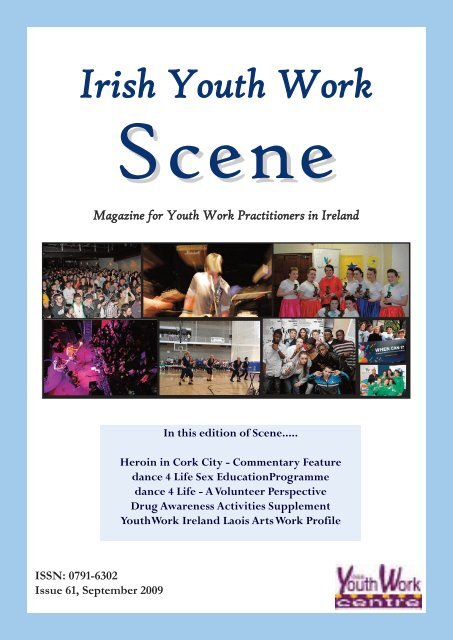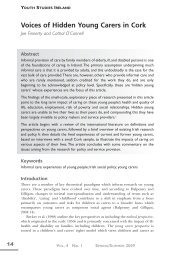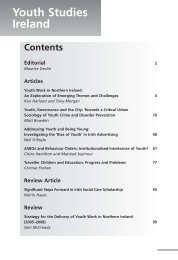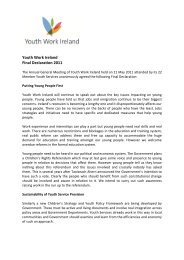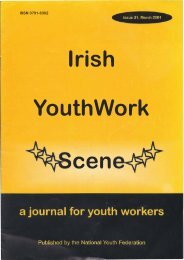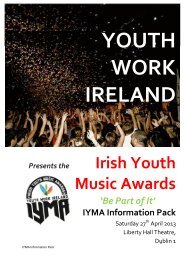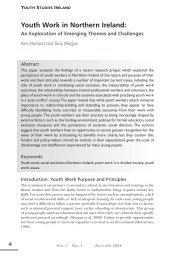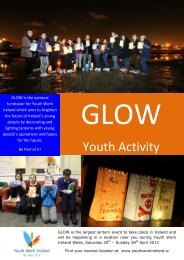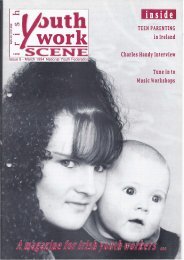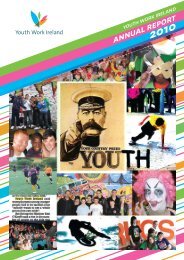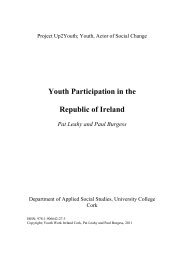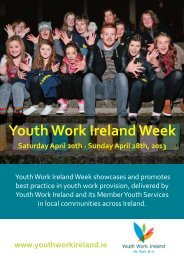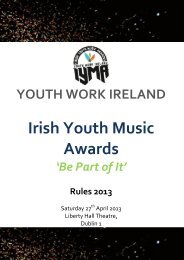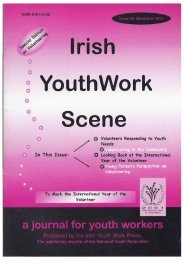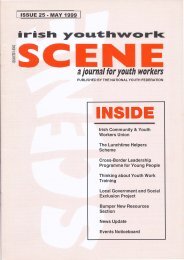Issue 61: September 2009 - Youth Work Ireland
Issue 61: September 2009 - Youth Work Ireland
Issue 61: September 2009 - Youth Work Ireland
Create successful ePaper yourself
Turn your PDF publications into a flip-book with our unique Google optimized e-Paper software.
Irish <strong>Youth</strong> <strong>Work</strong>SceneMagazine for <strong>Youth</strong> <strong>Work</strong> Practitioners in <strong>Ireland</strong>In this edition of Scene.....Heroin in Cork City - Commentary Featuredance 4 Life Sex EducationProgrammedance 4 Life - A Volunteer PerspectiveDrug Awareness Activities Supplement<strong>Youth</strong><strong>Work</strong> <strong>Ireland</strong> Laois Arts <strong>Work</strong> ProfileISSN: 0791-6302<strong>Issue</strong> <strong>61</strong>, <strong>September</strong> <strong>2009</strong>
CONTENTS:Editorial ....................................................... 2Heroin in Cork City ................................... 3dance 4 Life Sex Education Programme .. 8dance 4 Life - A Volunteer Perspective ... 9Drug Awareness Supplement ................... 11<strong>Youth</strong> Arts <strong>Work</strong> In <strong>Youth</strong><strong>Work</strong> <strong>Ireland</strong> Laois ................................... 15IYWC New Resources ............................. 17Round Up ................................................... 21Notice Board .............................................. 22Production Editors:Fran Bissett & Gina Halpin.Contributors: Fran Bissett, GinaHalpin, Aishling Hennessy,Diarmuid Kearney, Hugh Kearney,Ann Kennedy & Pat LeahyLayout: Gina HalpinPrinting: MetaphorDISCLAIMERIt is open to all our readers to exchangeinformation or to put forward points ofview. Send in news, comments, letters orarticles to the editors. Views expressed inthis magazine are the contributor’s own anddo not reflect those of the Irish <strong>Youth</strong><strong>Work</strong>Centre or <strong>Youth</strong> <strong>Work</strong> <strong>Ireland</strong>.Production Editors:Fran Bissett & Gina HalpinIrish <strong>Youth</strong><strong>Work</strong> Centre<strong>Youth</strong> <strong>Work</strong> <strong>Ireland</strong>20 Lower Dominick StreetDublin 1Tel: 01-8584500Fax: 01-8724183Email: info@iywc.comWebsite: www.iywc.comEditorialFollow the Yellow Brick RoadbyDiarmuid Kearney(CEO <strong>Youth</strong> <strong>Work</strong> <strong>Ireland</strong>)I’m wondering if the sector (along with many others) is suffering from some kindof paralysis at the moment. There seems to be little movement in progressing ourcollectively shared aspirations that seemed to be such a priority not so long ago.I’m not convinced however, that this is a consequence of the threat to funding resultingfrom what some euphemistically refer to as the economic downturn. Thereare of course many economic and political factors that can promote this inertia andcomments like ‘With the budget on the horizon we’d best keep our heads down’or ‘We don’t know who’ll be in government tomorrow so lets be cautious’ arenot uncommon or unreasonable. Indeed the cuts to funding already experienced,have for many resulted in a focus on survival strategies rather than development.But I’m also wondering if the economy is a convenient excuse for not naming thereal elephant in the room.As recent arrivals to the fold of the Office of The Minister for Children and <strong>Youth</strong>Affairs the youth work sector was cautiously optimistic. On the negative side wewere anxious that our non-formal educational approach would neither be valuednor understood. On the positive side the OMCYA heralded a fresh tilt at ‘joinedup government’ and a move away from the ‘silo’ system which has inhibited the deliveryof truly coordinated services. As a sector that works across many GovernmentDepartments we were excited by this prospect. Our experience to date hasnot realised these expectations. Silos are still very present. But perhaps we’vebeen a bit like Dorothy and her companions as they progressed along the yellowbrick road. We wanted, or rather, depended unrealistically on a ‘Wizard’ to pullthe strings and make things OK for us. But there isn’t anyone behind the curtainpulling the strings. There are a few people, who like us, believe a better job canbe done in working collaboratively alongside young people to have their rightsachieved. But it’s a collective effort that’s required.Like the lion we need to find courage; the courage to challenge the narrow thinkingthat prevents us working effectively, the courage to be innovative, creative andcritically reflective in our work and the courage to lead where leadership is required.Like the scarecrow we need to find a brain. We need to find the intelligenceto be strategic in our development, the intelligence to build the systemsand processes that will help us to be more effective in our work and the intelligencelearn from our experience. But perhaps most importantly, like the tin man weneed to find a heart; the heart to focus on what is really important. We need to findthe compassion that motivates us in doing this work for and with young people andnot for selfish personal or organisational reasons and we need to be kind to eachother in this work.We’re in the eye of the storm right now; let’s hope, like Dorothy, we get homesafely.Irish <strong>Youth</strong> <strong>Work</strong> Scene 2 <strong>Issue</strong> <strong>61</strong>, <strong>September</strong> <strong>2009</strong>
Feature ArticleHeroin in Cork CitybyPat LeahyIntroductionOver the last year or so it has become apparent thatheroin has finally arrived in Cork City. What issomewhat mysterious is how the city managed tomore or less escape from this particular drug for solong, and many anecdotal ideas (some that stretchcredibility to a staggering degree) have been advancedto explain this phenomenon.Regardless of Cork’s past good fortune the currentrather stark reality is that we now have a heroinscene in the City. This article seeks to inform thereader in relation to what might best be described asa major change in the (illicit) recreational drug useecology of Cork City, to provider a measure of informationon recreational drug use in general andheroin in particular, and to sketch out how theheroin situation might well develop in Cork overthe next year or so.It is important that society’s response to such anecological change is dictated by factual informationand by learning from the experiences of other areasin coping with this issue. Politicians, media and thegeneral public can be sucked into a panic and hypedriven response that can ultimately prove counterproductive;such a response has to be avoided if weare to minimise the damage and harm from heroin’sarrival in Cork.Heroin (or Diacetylmorphine/Diamorphine) is aderivative of the opium poppy, a plant that has beenused for thousands of years for medicinal, religiousand recreational purposes. This natural substancecontains dozens of alkaloids (the ‘active’ ingredientin a drug) two of which, morphine and codeine areof particular interest. Most of us are familiar withcodeine as a cough syrup and mild painkillerwhereas morphine is a powerful analgesic(painkiller); the isolated morphine element is up to1000 times stronger than raw opium. It is also extremelyaddictive.Heroin is in turn a derivative of morphine and aneven more powerful (and addictive) painkiller.This is somewhat ironic as the development ofheroin by Felix Hoffman for the German firmBayer in the 19th century was influenced by the desireto produce a non-addictive opium based medicine.The Bayer chemists ‘tested’ the substance onenthusiastic volunteers from the factory workforce;Heinrich Dreser coined the term heroin to reflectthe heroic feelings induced in said workforce by thenew drug (Jeffreys, 2008). Without going into toomuch detail the end result of the refining process ispure heroin; ‘a white, odourless powder with a bittertaste’ (Klein, 2002).Street heroin is ‘cut’ by various dealers in the supplychain to bulk up the product and therefore increaseprofit margins; all manner of stuff is used forthis purpose, common fillers include baking powder,talcum powder, flour etc. The appearance ofstreet heroin can therefore vary in colour and texture.The purity and the composition of street heroin isa source of considerable worry and danger to healthprofessionals and to heroin users alike. A batch ofhigh purity heroin can wreck havoc as the usersoverdose due to their lack of tolerance; a furtherdanger is the unknown composition of the bulkingagents. The heroin user may be smoking or injectingall manner of toxic agents.Whats Happening in CorkThe change in Cork’s drug scene due to the increasedavailability of heroin presents a further hazard;user ignorance. Cork has long been associatedwith ‘yokes and coke’; ecstasy and cocaine. In anyarea a drug culture will evolve over time that hasits own sets of rules and cultures including in asmuch as possible a ‘safe use’ culture. The user wantsto get high, not to die.Irish <strong>Youth</strong> <strong>Work</strong> Scene 3 <strong>Issue</strong> <strong>61</strong>, <strong>September</strong> <strong>2009</strong>
The Cork drug scene is only now incorporatingheroin into its panoply of substances and it is verylikely that the recent tragic deaths and injuriesattributed to heroin are at least partly due to userignorance. Most of us will be familiar with thespate of deaths and injuries that accompanied thearrival of ecstasy in the 1990’s and cocaine in theCeltic Tiger boom years; heroin is no different inthis regard. It is a sad fact that there will be accidentaldeaths from use; in the past we have witnessedboth moral panics and a surge in injuries anddeaths accompanying the appearance of new drugsand the likelihood is that heroin will follow thesame course.It can be quite difficult for the average person tounderstand the attraction of illicit drugs and evenmore so the attraction of heroin. The stark reality isthat most people who use heroin describe it as beingwonderful; heaven inside you. The pleasure derivedfrom the use of heroin has been described as “likebeing wrapped in cotton wool”. It is extremely difficultfor those of us who have never experienced thesheer euphoric feelings generated by this drug tofully comprehend just how fantastic this stuff actuallyis. However, heroin does have a nasty downsideand paradoxically it isn’t so much the drugitself as the conditions and qualifications on its usethat conspire to make heroin the substance with aruinous capacity to decimate people and communities.Heroin itself is actually a rather benign drug bar thedanger of overdosing; apart from the requirementto maintain use addiction doesn’t lead to healthproblems insofar as that the drug doesn’t attack thebody or poison a person as alcohol does. On theother hand, sharing needles virtually guarantees theacquisition of an infectious disease and as with allillegal drugs the user doesn’t really know what theyare purchasing as quality control does not exist. Theusing of needles causes all manner of skin problemsand the ‘junkie lifestyle’ is a prescription for harm.Self-neglect in diet and hygiene leads to problemsand the need to fund a habit causes risk-taking.On a local level the main form of use at this pointin time is still orally; the drug is smoked. This willprobably change however as smoking is wasteful; alot of the heroin literally goes up in smoke. Injectingis a far more cost-effective means of administeringthis drug and unfortunately it is probably onlya matter of time before this becomes prevalent inCork. The danger of overdosing is also increasedthrough intravenous use. This raises the questionof needle exchanges; on the one hand it is a provenmethod of reducing the spread of disease. However,the dilemma is that on the other hand access toclean syringes might well accelerate a shift to intravenoususe.The illicit drug user is also at risk of running afoulof the law through possession or supplying drugs.Hard-up addicts are frequently recruited as lowleveldealers in order to fund their own habit. Theviewpoint of those further up the supply chain isthat these people are disposable. Aside from thedevastation caused to individual users and theirfamilies a major effect of heroin is its impact on thesocial infrastructure of communities. A bag (theusual measure of consumption) of heroin costs €50,a heavy user could be going through three or fourbags a day; totalling €900 to €1,500 per week.This leads to acquisitive crime in order to fund thehabit with a commensurate effect on local communitiesas petty crimes such as handbag snatches increase.O’Mahony (2008) points out that mostheroin induced acquisitive crimes are committed bypersons who have already interacted with the criminaljustice system; the need for substantial sums ofcash to pay for the drug raises the incidents of crimedramatically. We must also consider that stolengoods are worth ten to twenty percent of their legitimatevalue so a €1,000 a week habit will require tento twenty thousand Euros worth of stolen goods.The characteristics of the population group in westernsociety who tend to be most at risk of developingextreme difficulties with heroin are typicallysocially excluded with poor social skills, difficultfamily backgrounds, high levels of social welfaredependency and educational under-achievement.This group of people tend to reside in poor qualityprivate accommodation, social housing or are technicallyhomeless. There is frequently a history ofpolydrug use; i.e. the individual will use just aboutany substance to get intoxicated. <strong>Work</strong>ing classinner city and suburban districts are most at risk;nevertheless the vast majority of the population inthese communities don’t engage in illicit drug use.They are ordinary law-abiding citizens with astrong commitment to their families and friendswho want to live their lives in peace and view illegaldrugs as a menace.Irish <strong>Youth</strong> <strong>Work</strong> Scene 4 <strong>Issue</strong> <strong>61</strong>, <strong>September</strong> <strong>2009</strong>
For the majority of the population the most likelynet result of a heroin surge will be an increase intheft, handbag snatches and suchlike activities. Theeffects on local authority housing estates can bemagnified though as the residents suffer from pettycrime and personal grief; a user who overdoses maybe a neighbour’s daughter or son. There is also thefear and alarm (especially amongst the elderly) asone’s neighbourhood decays and for parents the anguishof worrying that their children are at risk.One should not underestimate the levels of stressand mental torture in this regard as people do feelghettoised and abandoned by the state. <strong>Youth</strong><strong>Work</strong> <strong>Ireland</strong> Cork (YWIC) personnel have encounteredan increase in parental and communityenquiries in relation to heroin in recent months.One cannot rule out more serious crimes such as assaultsand muggings (including the use of syringesas weapons, although this particularly loathsomepractice is diminishing) to fund habits, typicallyhowever it is in the realm of supplying that moreserious crimes are committed as gangs enforce debtcollection, protect their business and sometimesfeud over territory. Again, this form of activity impactsfar more harshly on local authority areas aswe have seen in certain areas of Limerick andDublin. Ultimately, the arrival of heroin in the citywill probably not impact greatly on the majority ofthe city’s inhabitants but it may well be devastatingfor the areas and individuals that are affected.Economic FactorsA key area that is sometimes missed in debatesaround illicit drug use is that of economics; understandingthis particular element is critical in understandingthe wider issues that are wrapped up inproblematic and illegal drug use. Put simply, drugshave always been a profitable global business, frommedicinal substances, to tobacco (the drug thatcauses the most fatalities) to the socially accepted(alcohol, either consumed on licensed premises orused elsewhere) and onto illegal drugs where thescope for profit is immense.The use of heroin (and other drugs) throughout theworld is facilitated by the twin forces of globalisationand modernisation; modern society has erodedat least some of the cultural, traditionalist and religiousprohibitions on consumption; equally, globalisationhas seen the trade in substances rise as theworld becomes a smaller place. The phenomenonof failed ‘producer’ states (such as Afghanistan)wherein the government writ is not enforced alsoassists the cultivation and refinement of illegaldrugs. The risks of being caught (and executed insome states) running drugs do not act as a deterrentas enforcement agencies estimate that at most 10%of the cargo is interdicted; bear in mind that someof the massive hauls along the West Cork coast inrecent years were as a result of the incompetence ofthe traffickers.A ready supply of (usually) poor and desperate peopleis also harnessed to act as mules; ‘body packing’is a particularly dangerous practice as the mulesswallow the drugs in condoms to evade detection.These people run tremendous risks for relativelytrifling figures; they are most certainly not majorplayers or drugs barons (in many cases they arepaying off debts).Misconceptions on Usage and AddictionA common misconception is to equate using a drugwith addiction; this is not necessarily true and indeedmost recreational drug users (including illegaldrug users) do so in a reasonably safe and responsiblemanner. Alcohol for example, a particularly potentdrug, is used by the majority of the populationin a responsible and functional fashion, yet alcoholmisuse is one of the primary sources of social, familyand individual problems in contemporary society.The degree to which alcohol is even perceivedto be a drug by large swathes of the population isdebatable.Ecstasy, cannabis and even cocaine are used by otherwiselaw-abiding, employed and upstandingmembers of the community. Again, this is not todownplay the toxicity or potential dangers as mostrecreational drugs are powerful chemicals that affectmood, behaviour and emotions. It is when peopleuse to extremes, use in a dysfunctional manneror have underlying issues that serious troubles cansurface or be heightened by drug use. Addiction canbe constructed as the pinnacle of use insofar as thatthe drug use becomes a physical and/or psychologicalnecessity.Addiction is a heavily contested term, and not oneto be used lightly. In practice, it can be surmised asthe need to ingest a particular substance (alcohol,caffeine, tobacco, prescribed medications etc.) inorder to function. This explains why die-hard coffeedrinkers are rather bearish in the morning beforethey get their fix and why smokers areIrish <strong>Youth</strong> <strong>Work</strong> Scene 5 <strong>Issue</strong> <strong>61</strong>, <strong>September</strong> <strong>2009</strong>
incredibly grumpy if they can’t smoke. If you stopusing you get withdrawal symptoms; in some instancesthese are so severe that they can kill you.Many theoretical ideas have been advanced to explainaddiction; a disease, a physical dependency onthe drug, a pleasurable behaviour that we seek to repeat.There is no agreement amongst theorists inthis matter yet this critical area dictates responses topeople’s drug use.Aside from addiction we can get all manner ofchaotic and problematic drug use; people can getthemselves into all sorts of trouble; financial, emotive,physical and psychological from their drug use.But most people who use drugs in a recreational setting(including illicit drugs) don’t experience majorproblems with their drug use. This is important topoint out as throughout the world the people whotend to have the most difficulties with drugs arealso those who are marginalised from their societies.Anyone can become addicted or have a problematicrelationship with drugs; however the less well offhave fewer resources to assist them in overcomingtheir difficulties.How Can We Respond EffectivelyAll is not doom and gloom however; services andsupports do exist throughout Cork city. The firstline as such is the Local Drugs Task Force and itsnetwork of community based projects. These projectsoffer a diverse range of services to users (and insome instances families) and local communities andare staffed by committed and experienced professionals.These workers are not necessarily counsellors;many of them hold qualifications in areas suchas <strong>Youth</strong> <strong>Work</strong>, Community work and Social<strong>Work</strong>.This is important as in many cases a wider perspectivecan be invaluable in piecing together a person’sstory and in offering assistance. Our experience isthat users’ expectations can be unrealistic; peopleseek a quick fix solution for themselves or theirchildren. Unfortunately, there are no silver bulletsor magic wands available and a problem that mayhave been germinating for years cannot be resolvedovernight. People do seek accurate and factual informationas the information on the street can bewildly incorrect.Usually, there exists a ‘package’ of issues; drug usewill be one, therefore a package of supports is required.This can take a considerable length of time,years in some cases. Stability in resources and theability to have key personnel in place long termgreatly enhance a project’s capabilities. The communitylocation adds greatly to the accessibility ofthese projects and the workers local knowledge canbe utilised to garner supports at neighbourhoodlevel.At city level we have dedicated drugs rehabilitationand detoxification facilities such as Arbour Houseand additional ancillary services also exist (such asmental health and welfare services). Neverthelessthe issue of resourcing for these services is pressingand bedevils users and workers alike; as with thecommunity based drugs projects the new economicreality of recession must not be employed by policymakers to cut services. Indeed the opposite is true asrecessionary hard times are a fertile breedingground for inappropriate drug use.At the present time there is a need for an expandedmethadone maintenance programme in Cork; aswith so many other areas in drugs work this ishighly contentious; within our organisation wehave different views on the effectiveness this response.Such debate is healthy however; if there areany truisms in the drugs field it is that no-one hasall the answers (or even if answers exist) and all optionsmust be explored.Challenges for <strong>Youth</strong> ServicesFrom a youth work service providers’ viewpoint thecurrent situation presents a number of challenges;the priority is to offer support and assistance toyoung people who are using heroin whilst at thesame time maintaining current levels of service toother young people. A danger exists insofar as thata focus on heroin as the key current issue to the exclusionof other issues risks concentrating on thesubstance rather than the person.Trust is a major and sensitive issue; if a worker hasbeen in an area for a number of years this trust willexist; the individual themselves or their friendsmight know that ‘Mary’ or ‘Timmy’ are ‘sound’. Itis a big step for a person to seek help; users are suspiciousof the state or any organisation that can be(however tenuously) linked to the state as they feararrest and prosecution. The issue of confidentialityis important here; the worker must be viewed as impartialand non-judgemental by the drug user.The social conditions that conspire to place margin-Irish <strong>Youth</strong> <strong>Work</strong> Scene 6 <strong>Issue</strong> <strong>61</strong>, <strong>September</strong> <strong>2009</strong>
alised young people and their communities in thefrontline as users, dealers, vigilantes and victimscan be forgotten in the (media and politically fuelled)rush to be seen to be doing something aboutheroin. This usually includes the demonization ofcertain communities and young people. The onus isupon the youth services and other like-minded entitiesto avoid panic and respond in a rational ratherthan emotional manner.ConclusionsUp to six months ago in Cork the local drug scenein the main regarded heroin with deep suspicion ifnot outright hostility whereas cocaine and ecstasywere considered more or less to be ok. This haschanged and in the local scene heroin use is now becomingmore prevalent. It is important for all of usin Cork city to realise that a rubicon has beencrossed and there will be no going back; heroin willnot go away regardless of legal sanctions, politicaland community initiatives, preventative educationor moral outrage. This is not to adapt a passive ordefeatist stance; it is to simply acknowledge the reality.Cork has been lucky for a long time, now wemust live with and deal with a new reality. Citiesand countries throughout the world have implementedstrategies ranging from the crudely coercive(up to and including capital punishment for usersand dealers) to the sophisticated suite of servicesmodel (social, medical, economic supports etc.); inno case has either the supply or demand for the drugbeen significantly reduced.Heroin and the issues that surround it present uswith a complex and varied set of challenges; as individuals,families, communities and as a society.We must not forget however that the user is notsome form of evil fiend from hell intent on subvertingour civilisation or hooking our kids on drugs.They are also our fellow citizens; they want Cork towin all-<strong>Ireland</strong>s, want to lead ‘normal’ lives andworry about the situation that they are in. The frustrationsand angers that build up in communitiesdue to the damage attributed to heroin and otherdrugs are understandable but we must guard againstvigilantism or the hitching of ‘get tough on heroin’messages to political groups. Emotive responses canexacerbate the problems. Reducing both the supplyand demand involves a strong dose of commonsense, research, hard work, tolerance for differentopinions and a realisation that we cannot turn theclock back.The drug ecology in Cork has shifted but equilibriumwill eventually be restored. Heroin will ultimatelysettle into the Cork drug scene and remainthere until such time comes around that demandceases. But be aware that we humans like our drugsso don’t expect this to occur anytime soon.SourcesAshton, R., This is Heroin, (2002), Sanctuary Publishing:London.Klein, A., (2008), Drugs and the World, ReaktionBooks: London.O’Mahony, P., (2008), The Irish War on Drugs, TheSeductive Folly of Prohibition, Manchester UniversityPress: Manchester.Jeffreys, D., (2008), Hell’s Cartel, Bloomsbury: London.Pat Leahy is a lecturer in the Departmentof Applied Social Studies inUCC. His principle academic interestsare Young People and RecreationalDrug Use. He is also thechairperson of <strong>Youth</strong> <strong>Work</strong> <strong>Ireland</strong>Cork, a youth work organisation thatsponsors a Drugs Task Force Projecton the Northside of Cork City.Editors CommentRecent studies and media reportinghave pointed to the increased heroinproblem with usage outside of thebigger cities on the rise significantly.This commentary article we feel willresonate with many youth workersaround the country whether they areworking in Drugs Task Force Projects,Garda Diversion Projects orDisadvantaged <strong>Youth</strong> Projects.However, the article may also provokesome debate and critique and wewould be delighted to hear responsesfrom readers. Editors contact detailsare on the contents page.Irish <strong>Youth</strong> <strong>Work</strong> Scene 7 <strong>Issue</strong> <strong>61</strong>, <strong>September</strong> <strong>2009</strong>
Project ProfileThe dance4 Life Programmeby Ann KennedyIntroductiondance4life is looking for opportunities to work withschools and youth groups this autumn. One of thehighlights of the programme is the worldwidedance4life event, which will take place on Saturday27 th November 2010 to commemorate World AidsDay. Dance events are held in each participatingcountry and all events are connected via satellite.Besides getting a sense of the sheer scale of the programme,and how many different groups of peoplethe message has reached, the party culminates inthe entire dance4life community doing their drilltogether at the same time.What is dance4lifedance4life is a HVI/AIDS awareness se educationprogramme for young people. It is an internationalinitiative which aims to inspire, mobilise and uniteyoung people in the battle against HIV and AIDS.The programme was founded in 2003 and is now upand running in 20 countries. In 2006 dance4life arrivedin <strong>Ireland</strong> and it is hoped that the dance4lifeteam will visit schools and youth groups around thecountry.The programme is based around the dance4lifedrill, a dance that is taught to students in each ofthe participating countries. Although every countryis encouraged to add to the drill and make it culturallyunique, the dance gives students aconnection to participants from all around theworld. The programme in <strong>Ireland</strong> is run by theIrish Family Planning Association and is offered toschools and youth organisations free of charge.How it <strong>Work</strong>sThe tour team, made up of lively performing artsvolunteers, spend a few hours with students andyouth groups teaching them the drill. This is followedby the Skills4life Programme workshops.These workshops equip participants with a varietyof skills and information around HIV and AIDSand the way that it affects their lives and the livesof their peers’ world wide. During these workshopsparticipants will also explore their own sexual andreproductive health. The programme also coversself-esteem, decision making, respect and responsibilityand looks at the relationship between globaleconomic development and HIV/AIDS.Why this Training?This training seeks to give participants the knowledgeto protect themselves against HIV and othersexually transmitted infections; it also gives themthe tools to share what they have gained with theirpeers. With the help of the dance4life team at theIFPA, the student groups are then encouraged totake action within their communities in order tospread awareness of an issue they find particularlyimportant or relevant.Depending on the size and interests of the group,this can range from a survey of STI knowledgeamongst their families and friends to painting amural at a local park, to fundraising. In completingthis project, these young people become “agents ofchange” and are encouraged to continue activism forthose issues which are most important to them. Byusing music and dance, the dance4life programmeaims to reach youth in a meaningful way that remainswith them for life.Irish <strong>Youth</strong> <strong>Work</strong> Scene 8 <strong>Issue</strong> <strong>61</strong>, <strong>September</strong> <strong>2009</strong>
dance4Life:A Volunteers PerspectivebyHugh KearneyMy InvolvementUsing dance and music as a motivational tool to inspireyoung people to engage in issues surroundingHIV/AIDS is the basic premise of the dance4lifeprogramme. The programme was founded in 2003and is now up and running 19 countries spanningacross 6 continents and including over 50,000 youngpeople. In 2006 dance4life arrived in <strong>Ireland</strong> underthe auspices of the Irish Family Planning Association(IFPA). We plan to visit at least 12 schools aswell as a number of youth groups in autumn/winterof this year.The Heart Connection TourEssentially dance4life is a HIV/AIDS awarenesssex education programme for young people. Whatmakes it special is the use of dance, music and funto help young people engage in the issue of HIVand AIDS and to inspire them to get involved inthe global battle against the spread of the disease.There are number of distinct elements to the programme.I work as part of the Heart ConnectionTour which is comprised of arts volunteers. We arethe first group to visit the schools or youth groupsand our role is to teach the dance drill, to educatethem about HIV/AIDS and encourage them to becomeactivists.My involvement in dance4life began this summerwhen, through a friend in the Gaiety School of Acting,I heard that the IFPA was looking for volunteersfor what sounded like an exciting youthprogramme. As an aspiring actor I am always lookingfor a new challenge and it sounded like a reallygood cause to boot. As it turned out it was muchmore challenging than I had anticipated. We did aweek-long training session with Red Zebra, an internationaldance company that trains dance4lifeteams all around the world. I have little dance experienceexcept late night forays onto the dancefloor. So found it physically exhausting. By the endof August we were ready and did our first sessionwith a youth group from Kildare. Our first visit toa school was in <strong>September</strong> when we went to St MacDara’s Community College in Templeogue inDublin. The programme went down very well withthe students. I was surprised at how quickly thestudents got into it.This dance serves two purposes. First and foremostit is fun. AIDS and HIV are serious and at timesintimidating topics. The dance helps break the icewith young people and gets them engaged. Secondly,it provides a tangible physical link to all theother young people around the world who are alsoinvolved in the programme. The same dance (withsome local variations) is being taught in 19 differentcountries around the world, from places as far apartas Russia, Sierra Leone and Moldova. We have incorporateda bit of Irish dancing into our version ofthe dance. Young people can go online todance4life.ie and see their peers from all over theworld performing the same dance. Most recently agroup of young people from Tanzania uploaded aYouTube film of their version.Irish <strong>Youth</strong> <strong>Work</strong> Scene 9 <strong>Issue</strong> <strong>61</strong>, <strong>September</strong> <strong>2009</strong>
The grand finale of this element of the programmeis the worldwide dance4life event which takes placeevery two years on the Saturday before WorldAIDS Day. The next event is on 27 th November2010. Young people who have participated in theprogramme and attend the event will be connectedlive via satellite as they dance together in front ofthe world. This provides an exciting culmination tothe programme and serves to remind world leadersof the promises they have made to young peopleabout tackling HIV/AIDS.What it means to me<strong>Work</strong>ing with young people is new to me, but Ihave found it very rewarding. The fact that I amonly around eight year older than many of theyoung people were are engaging with makes for agood dynamic. I don’t look at them as “kids” anddon’t talk to the any differently than I would to myown peers. What I really like about the programmeis how genuinely enlightened the message is. I feelthat if we can turn even just one young person’s lifearound it is worth all the effort. In the comingweeks we will be bringing the programme to KillinardenCommunity School in Tallaght and thenonto Breifne College, Cavan; Drogheda <strong>Youth</strong>Reach, Co Louth; the CBS in Nenagh, Co Tipperary;Sutton Park, Co Dublin and CBS in Enniscorthy,Co Wexford.After the Heart Connection TourDuring the Heart Connection Tour we give youngpeople simple messages about HIV/AIDS such asthe fact that 60% of new infections were involvingyoung people between 15 & 24. We also do short dramassuch as a dramatisation of someone trying totell his friends that he has HIV illustrating the differentreactions and prejudices people have aboutthe disease. After the Heart Connection Team visitthe young people they are taught in more detailabout how to take responsibility in the skills4life elementof the programme. This is undertaken by ateam of sex education trainers from the IFPA.This is an in-depth programme where they learnmore about HIV and AIDS and how it can affecttheir lives and those of their peers in the developingworld. During this element they will also exploreissues such as self-esteem, decision making and respectand responsibility.Once they’re fired up they’re ready for the thirdpart of the programme, which is called act4life. Asthe name suggests this is all about taking actions ofactivism. Young people are encouraged to becomeagents of change and engage in personal actions.This could mean anything from becoming a volunteer,fund raising or simply spreading awareness. Aschool in Dublin, for example, did a No-UniformDay fundraiser for HIV/AIDS.Hugh Kearney pictured above is a volunteer withthe Irish Family Planning Association’s dance4lifeprogramme.For more information on thedance4lifeprogrammeplease contact:Ann KennedyCoordinator dance4life <strong>Ireland</strong>Tel: 01-8069444Email: dance4life@ifpa.ieWeb: www.dance4life.ieIrish <strong>Youth</strong> <strong>Work</strong> Scene 10 <strong>Issue</strong> <strong>61</strong>, <strong>September</strong> <strong>2009</strong>
Drug Awareness Activities SupplementbyGina HalpinIntroduction:Drug awareness education is key to preventingyoung people from becoming engaged in experimentingwith drugs, which occurs initially out ofcuriosity or peer pressure, and without the fullknowledge or awareness of the devastating effectsof drug use. This activity supplement hopes toequip youth workers with exercises and informationto help them engage with young people aroundthe issue of drug use.Drugs Classification:Drugs are described in different ways. People usewords like 'soft', 'hard', 'upper' and 'downer'. Classifyingthem can help make sense of what they doto us.Stimulant (upper)Stimulants speed up the brain and central nervoussystem. Examples are caffeine (in coffee, tea) nicotine(in cigarettes), amphetamines (speed, dexamphetamine,diet pills), cocaine, and ecstasy.Depressant (downer)Depressants slow down the brain and central nervoussystem. Examples are alcohol (beer, wine,vodka, gin, etc.), marijuana /cannabis ('dope','grass', 'weed', etc.), fantasy, heroin, tranquillisersand anti-anxiety drugs (including sleeping pills).Hallucinogen (psychedelic)These drugs alter the user's state of consciousness,and include drugs such as LSD ('acid', or 'trips'), ecstasy,PCP, magic mushrooms, datura and marijuana/cannabis.The most commonly used drugs inmany countries are alcohol, tobacco and prescriptiondrugs. Alcohol and tobacco are also the biggestkillers.Marijuana is the most commonly used illegaldrug.Ice BreakerDefinitions....Aim: To get the group comfortable with each other& to encourage the young people to share their understandingof what is meant by the term ‘drugs’,both legal and illegal.Materials: Flipchart paper & markers.Begin by asking the group to brainstormthe names of as many drugs as they can -stress that you are not asking how manythey have used or seen, just heard of.Record these onto flipchart paper as theyoung people call them out.Split the young people into groups of 3 or 4,their challenge is to come up with a definitionof what a ‘drug’ is to them. They canillustrate this if they want to - the point isto discuss the term and reach agreement.Once everyone has finished invite eachgroup to share what they have come upwith.Display the young people’s definitions onthe wall of the youth club.Source: A Little Book of Drugs, by Vanessa RogersActivity OneWhy do Young People UseDrugs?Aim: To explore the role of druguse among young people and toexplore the differences and similaritiesbetween young people andadults in relation to drugs use.Materials: Flip chart paper, pens & markers.Divide the group into smaller groups of fouror five.Give each group a flip chart page with theIrish <strong>Youth</strong> <strong>Work</strong> Scene 11 <strong>Issue</strong> <strong>61</strong>, <strong>September</strong> <strong>2009</strong>
statements ‘Reasons for Use’ and ‘Reasonfor Non Use’ written on it.Ask some groups to brainstorm the reasonswhy some young people choose to usedrugs and why some choose not to.Ask the other groups to brainstorm thesame task but to focus on adult use andnon-use of drugs.Give the groups 15-20 minutes to brainstorm,then bring them back and ask themto feedback to the bigger group.Using a flipchart list and compare the reasonsrecorded for young people and thoserecorded for adults.If time permits, start a group discussion usingsome of the following statements:1. Are there different pressures or influencesaffecting males and females to use drugs?2. How does your circle of friends influencewhether a person uses drugs or not.Source: L.E.A.D. - Leading Education About Drugs, by HelenCahillActivity Two:Handling Pressurein the MomentAim: To enhance skills indealing with peer pressureof peer invitations to engagein drug use. This exercisewill give young peopleprepared ideas and answersas to what to do if they areinvited to use drugs.Materials: Lines of Offer Cards and Tactics Cards(see below for details of these cards)Explain to the young people that knowinghow to deal with pressure from friends touse drugs is very important.Organise the role plays by asking the groupto form into groups of three or four.Give the Lines of Offer Cards (see below- write or print these statements on a postcard prior to the group work) to each groupand ask them to work out a response inwhich they decline the offer to use drugs.Make it clear that the offer is to be madeby one person to the two others who do notwant to take up the offer.Challenge the young people to develop ascene in which those refusing the offer donot come across as the less attractive characters- but rather as funny, clever andwhitty.Remind the young people that the role ofthis activity is to model ways in whichyoung people can decline drug offers without looking like a ‘loser’.For a focus on tactics have the young people choosean approach for themselves or alternatively use theTactic Card (see below - again have these card prepreparedbefore the group meets).Lines of Offer Cards:Put pressure on the other player by suggesting that:They’re too scared to try the drugs!Tactic Cards:Deal with the pressure by:StallingChanging the subjectMaking an excuseDistractingExplainingEveryone else is doing it!Doing drugs will make them look cool!Their party will be rubbish without drug!No one will ever find out about their drug use!Everyone tries it at some time!It will help them relax and cope with stress!It’s a special occassion & they should celebrate!It will make them more attractive!It can do no harm!Complain about somethingyou have to doJokingReasoningArguingIgnoringSource: L.E.A.D. - Leading Education About Drugs,by Helen CahillIrish <strong>Youth</strong> <strong>Work</strong> Scene 12 <strong>Issue</strong> <strong>61</strong>, <strong>September</strong> <strong>2009</strong>
Activity Three:What Happens NextAim: To encourage young people to think throughpossible consequences of drug related situations.Materials: Flip chart paper for each group, pens andmarkersDivide the group into smaller groups ofthree or four and give each group a differentscenario.Explain that each senario depicts a situationwhere drug use is an issue.Give each group flip chart paper & markers& ask them to construct a comic strip toshow what happens next.Encourage the groups to think about theconsequences of actions, what they mayhave done differently in the situation andwhat could be done to resolve the scenario.Scenarios1. A 14 year old youth is caught at schoolwith cannabis in their school bag.2. A 21 year old man offers an ‘E’ to a 15 yearold girl he has just met in a club.3. A 17 year old young woman passes out at aclub after doing a line of cocaine.4. A 16 year old student tells her teacher thatshe uses cannabis to relax her.Source: A Little Book of Drugs, by Vanessa RogersActivity Four:Drugs in SportsAim: This is a discussion activity to look at theissue of drugs in sports and explore values and attitudeswithin the youth group.Materials: A red, yellow & green card for eachperson and a copy of the drugs in sports warm up(see below - this can be either written up on a flipchart page prior to the group meeting or photocopiedand given to each young person.Give each young person a yellow, greenand red card. Explain that you are going toread a series of statements and you wantthe young people to raise the card that correspondswith their opinionRED - No, I disagreeYELLOW - I want to say something about thisGREEN - Yes, I agreeAllow time for people to ask questions or makecomments about thestatements. If no oneuses a yellow card, youcan ask questions orchallenge red & greencard answers.DRUGS IN SPORTWARM UPRandom drugs tests are the only way to stop athletescheating.Drugs in sports have only been a problem since the1980s.Athletes caught using steroids should be barred forlife from competing.Disabled athletes should be subject to the same drugrules as other athletes, otherwise, it isn’t fair.If someone refuses a drugs test then he/she musthave something to hide.It would be better if every sportsperson was drugstested before competing.Athletes should provide good role models for youngpeople.If a sportsperson is found to have used drugs beforewinning a medal then it should be taken away fromthem.Athletes who are wrongly convicted should begiven their titles and medals back.Some over-the-counter remedies for colds and flucontain banned drugs that can make athletes testpositive for drugs.Source: <strong>Youth</strong> <strong>Work</strong> Now, January <strong>2009</strong>Irish <strong>Youth</strong> <strong>Work</strong> Scene 13 <strong>Issue</strong> <strong>61</strong>, <strong>September</strong> <strong>2009</strong>
Activity Five:Challenging StereotypesAim: To challenge young people’s assumptionsabout drug using and drug users.Materials: Flip chart paper,markers, blu-tack and pieces ofcard labelled - Cannablis User -Alcohol User - AmphetamineUser - Ecstasy User - AerosolUser - Heroin User - CocaineUser - Person who does not usedrugs.Divide young people into small groups andallocate one card to each group.Ask them to draw what they think the personusing drugs looks like.Stick the drawings on a wall and then askthe young people to guess from each other’sdrawings which drug the person uses.Next ask how they made these decisions,what information or knowledge it was basedon and if their assumptions were correct.Introduce the idea of stereotypes.Discuss what it means and offer the following definition “A stereotype might be defined as a generalisation and assumptionthat, together, portrays the reputation of agroup”.Group Discussion:1. Are the drawings stereotypes?2. Do most users of that drug really look likethat?3. How are gender, age and ethnicity representedin the drawings?4. Can you tell who might use or not use differentdrugs just by looking at them?5. What can happen if incorrect assumptionsare made about people?Finally ask the young people to share their own experiencesof being stereotyped and conclude thatyou cannot always tell if a person is using or misusingdrugs just by their appearance, the music theylisten to or the friends they have.Source: <strong>Youth</strong> <strong>Work</strong> Now, January <strong>2009</strong>Useful Websites & OrganisationsAna Liffey Drug Projectwww.aldp.ieMerchants Quay <strong>Ireland</strong>www.mqi.ieChildren’s Rights Alliancewww.childrensrights.ieCommunity Awareness of Drugswww.aboutdrugs.ieCrosscare Drug And AlcoholAwareness Programmewww.drugs.ieHeadstrongwww.headstrong.ieHealth Promotion Unitwww.healthpromotion.ieNarcotics Anonymouswww.na-ireland.orgNational Drugs Helpline1800 459459National <strong>Youth</strong> Health Pr0grammewww.youthhealth.ieReach Outwww.reachout.com.auSpunoutwww.spunout.ieGina Halpin is the Information & Resources Officerwith the Irish <strong>Youth</strong><strong>Work</strong> Centre.Irish <strong>Youth</strong> <strong>Work</strong> Scene 14 <strong>Issue</strong> <strong>61</strong> <strong>September</strong> <strong>2009</strong>
<strong>Youth</strong> Arts <strong>Work</strong> in <strong>Youth</strong> <strong>Work</strong> <strong>Ireland</strong> LaoisService ProfilebyAishling HennessyIntroduction<strong>Youth</strong> <strong>Work</strong> <strong>Ireland</strong> Laois has worked tirelesslyover the last year to promote and support the artswithin the youth Community in Portlaoise andthroughout Laois. Within the last year <strong>Youth</strong><strong>Work</strong> <strong>Ireland</strong> Laois has encountered massivechanges from re-branding to moving premises tonew Project Manager to the launching of our <strong>Youth</strong>Café! Lots of change can only result great things tocome. Our Arts focus over the last year has increasedgreatly due to the committed work of<strong>Youth</strong> Arts <strong>Work</strong>er, Aishling Hennessy, <strong>Youth</strong><strong>Work</strong>er, Aoife Walsh, Office Co-ordinator, NicolaCoss and Project Manager, Joe Thompson.This work started with the massive success of theHaunted House Project in 208, which saw over 50young people, aged 13-17 from all over Abbeyleixparticipating. Props we’re made, costumes were designed,sets created and performances were rehearsed.A fantastic night was had by all involved.From there, we set about promoting our next seriesof workshops. Photography, Painting and Ceramicsworkshops took place from March to April ’09 witha great reaction from the young people of Laois.Photography workshops gave the participants theopportunity to look at Portlaoise through the lensesof their cameras. Painting workshops allowed theyoung people to display their individuality throughthe medium of paint while also using mixed mediato create texture and depth. Ceramics workshopssaw Ceramicist Eleanor Swan from Kildare workwith us. Her energy and Artists Way was quite obviousto us as she worked with the young people.The ceramic pieces created we’re a symbolic to theirexperience with Eleanor as each piece was beautifullysculpted, glazed and exhibited.Ceramics <strong>Work</strong>shop <strong>2009</strong>Graffiti Project <strong>2009</strong><strong>Youth</strong> Arts ProgrammeIn January, we saw the first of our <strong>Youth</strong> Arts Programmefor <strong>2009</strong> take place. All workshops werekindly supported by Portlaoise Credit Union andLaois County Council. Animation workshopsstarted in January with innovative work producedby the participants! From skydiving monkeys tomartial arts men, the characters created by thegroup became a great insight into technical mindsof our youth and their ability to demonstrate theircomputer graphics capabilities.D’ YOUTH FACTORY Launch<strong>Youth</strong> <strong>Work</strong> <strong>Ireland</strong> Laois officially opened itsdoor to the public with the launch of D’ YOUTHFACTORY on 20 th June. To coincide with thisevent, we set about displaying to greater communitythe artistic abilities of the young people involvedwith us through “The Tunnel”. This pieceof Graffiti Art was created in the archway betweenThe Fruit ‘n’ Nut Place and Portlaoise Pharmacy.Over 20 young people were involved in this projectand the results of the hard work are on display forthe public to see. A week later saw Graffiti workshopsstart for two weeks. These workshopsbrought together over 30 young people who setabout creating fifteen 8x4 pieces of graffiti art.Irish <strong>Youth</strong> <strong>Work</strong> Scene 15 <strong>Issue</strong> <strong>61</strong>, <strong>September</strong> <strong>2009</strong>
Our final blast of energy came about through theorganisation of D’Rock Garden Party on 20 th of Augustby D’Rock Garden Sub Committee, whothought it was a good opportunity to bring togetherthe <strong>Work</strong>shop, Club and Cafe Members for a celebrationof achievement of the very successful GraffitiArt, Tunnel, Stomp Music Summer<strong>Work</strong>shops and Charity Pig Race event in associationwith the Magnet Portlaoise Festival whichraised €1,554.38 for the <strong>Youth</strong> Centre. The sub-committeesuccessfully demonstrated leadership and organisationskills fo the following key activities:Cody McDonald ( Stage and Safety Coordinator),David Harte (Technical Coordinator), CaoimheCommins and John Delaney (Promotions Coordinators),Sid Thompson (Artist and Set Coordinator),Kearin Robrts (MC) and Niamh Cahill (DJ).D’YOUTH FACTORY launch <strong>2009</strong>These workshops were facilitated by Athy ArtistBen Pateman and Portlaoise Artist Alan Scully.Stomp Music workshops took place for two weeksin July with participants creating their own Musicinstruments with the facilitation of local musicianRoss O’Meara. Over the course of two weeks, theyoung people learned body percussion, beat andmade instruments from recycled materials. Theyworked as a group to compose pieces of music usinga mixture of body percussion and instruments. Themain piece composed by the group was Billy Jeanby Michael Jackson. The workshop was also featuredby Claire O’Brien on Midlands 103.To put into words the amount of Arts related learningthat has been displayed throughout the lastyear, is in honesty, quite difficult. The young peopledemonstrated not only artistic abilities but alsomaturity, friendship, team work, organization andabove all else a sense of responsibility for each projectssuccess. To witness this, should prove to thesceptics that young people really can contributepositively to our Community and their opennessand free spirit should be characteristics we embrace,not diminish.Please get in touchIf you are interested in becoming a volunteer withus, curious as to what is we do or interested in upcomingworkshops, please feel free to drop into uson the Abbeyleix Road from 9.30 am – 1pm and 2pm– 6pm. The <strong>Youth</strong> Café is open daily with JuniorGroup (1 st – 3 rd year) meeting Mondays from 4-6pm.Senior Group (4 th – 6 th year) meet Tuesdays from 4-6pm. Wednesdays are dedicated to Arts workshops.Thursdays is our drop-in evening from 4-7pm andFridays are our Friday Nite Live from 5-9pm. Membersonly so pop in for application and Parental consentform.Aishling Hennessey is the <strong>Youth</strong> Arts <strong>Work</strong>erwith <strong>Youth</strong> <strong>Work</strong> <strong>Ireland</strong> Laois. For furtherinformation on the service or any of the activitiesmentioned please contact:Rock Garden Party August <strong>2009</strong><strong>Youth</strong> <strong>Work</strong> <strong>Ireland</strong> LaoisShamrock HouseAbbeyleix RoadPortlaoise,Co Laois.Tel: 057 8665010Fax: 057 8665010Email: info@ywilaois.ieWeb: www.ywilaois.ieIrish <strong>Youth</strong> <strong>Work</strong> Scene 16 <strong>Issue</strong> <strong>61</strong>, <strong>September</strong> <strong>2009</strong>
IYWC New ResourcesGLOBAL YOUTH WORKGlobal <strong>Youth</strong> <strong>Work</strong>: Taking it PersonallybyMomodou Sallah and Sophie Cooper, 2008Resource pack containing a host ofreasons why youth workers should involvethemselves in Global <strong>Youth</strong><strong>Work</strong> - as well as a range of practicalways in which they can do so. Gearedtowards practitioners it will helpmake the personal, local, national andglobal connections between ‘things out there’ and‘things in here’. The ten sections consider a range ofissues, from the economic and security implicationsof globalisation, and how these stretch beyondmoral and green imperatives, to globalisation andhuman values; body image; gangs and crime; theclothing industry; refugees; the war on terror; religiousidentity; music and sustainable developmentand the way we live.HEALTHMind: Emotional Health and WellbeingActivities for Young PeoplebyVanessa Rogers, 2007Good emotional health enables youngpeople to feel happy respected and content.It also enables them to value andrespect the worth of others. Developingyoung people’s emotional wellbeingcontributes to an overall healthylifestyle and gives them a valuable resource to usein everyday life. This activity pack provides atoolkit of ideas and activities for youth workers andother professionals working with young people toexplore good mental health and emotional wellbeing.This pack comprises of five sections - Warmup activities; Emotional wellbeing exercises -Anxiety & stress; Expressing feelings & emotionsand finally ideas for reviewing and reinforcinglearning.Soul: Spiritual Health and Wellbeing Activitiesfor Young PeoplebyVanessa Rogers, 2007Activity pack written to supportyouth workers and other professionalsin exploring beliefs, values andethics with young people. Looking atspirituality in the widest sense theseactivities encourage young people to question boththemselves and what they see in the world aroundthem. The pack consists of six sections - Warm upactivities; Exercises that encourage young people toexplore what it is that makes them unique; Personalbeliefs and values; Exploring ethics and finally Relationshipsand spiritual awarenss.INTERNET SAFETYOnline GroomersbyDr. Julia Davison & Dr. Petter Gottschalk, <strong>2009</strong>The Internet has greatly facilitatedthe ways in which paedophiles cangroom children and young people.This important book offers numerousnew insights and, in the process,provides a sound conceptual approachto understanding continuing developmentsin: (i) Characteristics of the Internet (ii)How these are explored and exploited by sexualoffenders to groom their victims (from the initialtargeting of sites where children and young peoplevisit online, contacting their potential victimsand forming a bond, through to the abuse takingplace) (iii) Legislation against online grooming(iv) The conviction, understanding and treatmentof offenderspreventing them from causing harm.The book is aimed at anyone responsible for thecare or safeguarding of children and young people.It places examples from current technologyand laws within the rapidly developing interna-Irish <strong>Youth</strong> <strong>Work</strong> Scene 17 <strong>Issue</strong> <strong>61</strong>, <strong>September</strong> <strong>2009</strong>
tional context of online child protection; and providespolicy and practice information on:Profiling online groomersPoliicing online groomersPreventing online grooming offencesIt uses international examples to illustrate largerconcepts and cases, and the difficulties involved intackling a world-wide problem where individualcountries have their own laws protecting children,but where there is no concerted law enforcementand international legislation to combat child abuse;and where there is no direct governance of the Internetby an international body to curb illegal onlinecontent and activity. Above all, this bookdemonstrates how people working in many differentspecialisms and countries can co-operate to helpensure children and young people remain safe online.SOCIAL EQUALITYThe Spirit Level:Why more equal societies almost always do betterbyRichard Wilkinson & Kate Pickett, <strong>2009</strong>Large inequalities of income in asociety have often been regardedas divisive and corrosive, and it iscommon knowledge that in richsocieties the poor have shorterlives and suffer more from almostevery social problem. This book,based on thirty years’ research, demonstrates thatmore unequal societies are bad for almost everyonewithin them - the well-off as well as the poor. Thedata the book lays out and the measures it uses arelike a spirit level which can be held up to comparethe conditions of different societies. The differencesrevealed, even between rich market democracies,are striking. Almost every modern social and environmentalproblem - ill-health, lack of communitylife, violence, drugs, obesity, mental illness, longworking hours, big prison populations - is morelikely to occur in a less equal society. The book goesto the heart of the apparent contrast between thematerial success and social failings of many modernsocieties.The research contained in this book, does not simplyprovide a key to diagnosing ills. It tells how toshift the balance from self-interested ‘consumerism’to a friendlier and more collaborative society. Itshows a way out of the social and environmentalproblems which beset societies and opens up amajor new approach to improving the real quality oflife, not just for the poor but for everyone.YOUTH WORK RESEARCHChildren and Young People in <strong>Ireland</strong> 2008byCentral Statistics Office, <strong>2009</strong>The social partnership agreement2003-2005 requested the CSO tosupport a move towards more evidence-basedpolicy making. TheNational Statistics Board furtherrequested that the CSO provide acomprehensive set of social indicatorswith emphasis on disaggregationby key characteristics such as the nine equalitygrounds. The first set of social indicators publishedby the CSO focused on the theme of gender. Othersocial indicator reports have focused on ageing,equality and regional quality of life. This reportcompliments the earlier report on ageing. The reportis focused on the 0-19 years age group or preteenand teenage years. Most indicators arepresented in either a national or international context– the indicators used are (i) Population (ii) Education(iii) Health & Care (iv) Transport, societyand lifestyle. The national context is generally in atime series format while the international contextcompares <strong>Ireland</strong> principality with other EU countries.Get ‘em Young:Mapping Young People’s Exposure to AlcoholMarketing in <strong>Ireland</strong>byNYCI, <strong>2009</strong>Research aimed at examining if<strong>Ireland</strong>’s stated commitment toprotect young people from thepressure to drink is reflected in theactual experiences of young people.The project was designedwith young people as co-re-Irish <strong>Youth</strong> <strong>Work</strong> Scene 18 <strong>Issue</strong> <strong>61</strong>, <strong>September</strong> <strong>2009</strong>
searchers to provide a better understanding of theirexperiences and to improve the credibility of theknowledge that is derived from research involvingyoung people. Marketing and advertising play amajor role in forming and shaping opinions, attitudesand behaviour in our society. The drinks industryis among the highest spenders in this sector;however they state that their activities do not targetyoung people. This report is unique in that for thefirst time in <strong>Ireland</strong>, young people record their experiencesof alcohol advertising and marketing intheir surroundings and environment. This mappingreport was conceived as part of a broader examinationof the impact alcohol marketing.Report on Consultations for an Inter-CulturalStrategy for <strong>Youth</strong> <strong>Work</strong>byLisa Mauro-Bracken, <strong>2009</strong>Report summarises information gathered as part offocus group consultations held with young people,their parents, youth workers and representatives ofminority ethnic communities including youthworkers from minority ethnic backgrounds. It highlightsthe range and depth of comments made duringthe consultation phase of the development of anintercultural strategy for youth work. There werea number of reoccurring themes, which emerged;the general findings demonstrated that the equalityfocus at the local level is not significant, with limitedinclusion programmes and activities being implemented.YOUTH WORK PRACTICEMixed Up KidbyTina G. Patel, 2008More & more children are growingup in mixed-race families and socialenvironments and there is alsoincreasing variety within thismixed-ness. Yet services for themhave been bogged down by restrictivepolicy and practice guidelinesbased on: (i) Outdated and problematicideas about essentialised racial identities(ii) The supposed need for children to commitfully to one of these identities (usually the blackminority ethnic one) in order to minimise identityproblems and experiences of discrimination.This book is aimed at anyone working with suchchildren and young people - in social work, adoptionand fostering, education, youth work andyouth justice - this book asks:1. Why essentialist ideas about a single identitytend to dominate.2. What the consequences are for those who actively choose not to identify themselves ashaving a single racial identity.3. How policy and practice can be improved.The autor provides thought provoking analyses ofexisting literature, and calls for recognition of theseindividuals, for example those who were transraciallyadopted as children, and whose reflective narrativesform a major part of this book.Just Like a JournalistbySuzy Bender, <strong>2009</strong>User-friendly resource for helpingyoung people to develop communicationand creative skillsthrough informal experiences ofjournalism, including: (i) Writing(ii) Interviewing (iii) Editing(iv) Creating images (v) Presentationof text and images onpaper and on the web (vi) <strong>Work</strong>ing in groups(vii) Creating a flyer, info sheet or newsletterfrom scratch (viii) Contributing to existing clubor school newspapers (ix) Making submissions tolocal newspapers and magazines (x) Getting apoint across in print and on the web.The materials can be used flexibly by anyone withyouth work or teaching skills - no experience ofjournalism is required. This is not a complex programmethat has to be worked through from beginningto end, but an informal, engaging andcoherently presented collection of guidance, information,suggestions, activities and anecdotes thatcan be used flexibly in any of the above circumstances.It is written by an experienced journalist who hashelped young people contribute to youth publicationsover several years. The material which ispresented here in informal and engaging ways -can assist youth leaders, youth workers and teach-Irish <strong>Youth</strong> <strong>Work</strong> Scene 19 <strong>Issue</strong> <strong>61</strong>, <strong>September</strong> <strong>2009</strong>
ers to add some specialist skills and experiencesin their work with young people in clubs, schools,detached settings or anywhere else where theymeet with them who may:1. Aready have a strong desire to write and‘publish’, but don’t know how to go about it.2. Want to become journalists.3. Have strong views about something that hasarisen and need encouragement and help to organise’a voice’.4. Benefit from encouragement to join in existingopportunities such as contributing to theirschool or club newsletter.YOUTH WORK PROVISIONGetting better all the Time:Case Studies of Improving <strong>Youth</strong> <strong>Work</strong> ServicesbyBryan Merton, Rob Hunter and Harriet GoreBook aimed at highlighting thelessons that can be learned fromservices that have brought aboutsignificant changes to the wayservices work in order to raisestandards of youth work provisionand practice. Themes have beenselected that impact on qualityoutcomes for young people, case studies describehow these have led to organisational developmentand service improvements and reference is made tomodels of change management to help pull the variousthreads together.The book is invaluable reading for all those who areresponsible for developing policies and services foryoung people; those who fund, plan, commissionand manage these services; and the front line staffwho deliver the work. It will assist in planning andmanaging any changes that are necessary to raisestandards so young people can achieve the best possibleoutcomes.Good <strong>Youth</strong> <strong>Work</strong> -What <strong>Youth</strong> <strong>Work</strong>ers Do, Why and HowbyBryan Merton, 2007Book which describes and explainsgood youth work, drawing on thereflective practice of those who doit. It is aimed at practitioners andmanagers of youth work, whereverthey are located, and at policymakers and commissioners whomay want to know about the workthey support. By examining what good youth workersdo the book aims at making youth work practiceexplicit, visible and comprehensive; and thereby revealingits complexities, nuances and the differentkinds of knowledge, skills, resources and insightthat youth workers draw on in their everyday work.In doing so, the book hopes to illuminate whattends to be obscured by the phrase ‘the youth workapproach’ and show how youth workers operatewith sometimes very challenging young people inoften difficult circumstances.All these titles are availableON LOAN - not for sale -to Irish<strong>Youth</strong><strong>Work</strong> Centre members.For further information or to request anyof these titles please conact:Gina Halpin / Breege KiernanIrish <strong>Youth</strong>ork Centre20 Lower Dominick StreetDublin 1Tel: 01-8584500Fax: 01-8724183Email: ghalpin@youthworkireland.ie /bkiernan@youthworkireland.ieWebsite: www.iywc.comIrish <strong>Youth</strong> <strong>Work</strong> Scene 20 <strong>Issue</strong> <strong>61</strong>, <strong>September</strong> <strong>2009</strong>
Round UpGrowing Up in <strong>Ireland</strong> <strong>2009</strong>Reserach ConferenceThe Economic and Social Research Institute (ESRI)and Trinity College Dublin will host the inauguralGrowing Up in <strong>Ireland</strong> Research Conference inDublin on 7th December <strong>2009</strong>. Growing Up in <strong>Ireland</strong>is the only nationally representative longitudinalstudy of children in <strong>Ireland</strong>. It follows theprogress of almost 20,000 children — a cohort of8,500 9-year-olds and a cohort of 11,000 9-montholds.It will provide the basis for research and policyformation for many years to come.Mr. Barry Andrews T.D., Minister for Childrenand <strong>Youth</strong> Affairs, will open the conference withthe official launch of the study’s first main reporton 9-year-old children..The aim of this one-day conference is to:Present research findings from the study.Examine the contribution of the study to our understandingof children and childhoodConsider the study’s research and policy potentialKeynote speakers include Dr. Satya Brink(HRSDC), Professor John Bynner (Prof. of SocialSciences in Education - London Institute of Education,Prof. Sir Michael Rutter (Institute of Psychiatry,Kings College, London)A conference brochure and registration form willbe distributed in the coming weeks.All enquiries to Claire Delaney,Growing Up in <strong>Ireland</strong>,Tel: 01-8632053Email: claire.delaney@esri.ieThird Level Access Scheme extendsto all secondary schoolsThe Higher EducationAccess Route (HEAR)is being extended by theseven universities, DITand the seven collegesof education from 305 toall 730 secondary schools in <strong>Ireland</strong>. The schemewill broaden access opportunities to third level educationfor school leavers from disadvantagedsocio-economic backgrounds across the country.This expansion of the scheme, which was primarilyreserved for students from DEIS schools, recognisesthat educational disadvantage affects a crosssection of all communities and is not confined toclearly identifiable areas or regions.Under the Higher Education Access Route, participatingcolleges are allocating a quota of places on areduced points basis, across all academic areas. Studentswho secure one of these places will be offereda range of academic and personal supports while atcollege. Since the inception of the access admissionsscheme a decade ago the number of studentswho have entered college through the Higher EducationAccess Route has grown steadily from 175 in2000 to 682 in <strong>2009</strong>.For the first time, school leavers who wish to applyfor the scheme can do so online as part of the CAOapplication process. Applications open from 1st November<strong>2009</strong> onwards. A dedicated websitewww.accesscollege.ie has also been developed toprovide full details of the scheme and assist studentsin making their application.For further information contact:Lia O’SullivanCommunications ManagerIrish Universities AssociationTel: 01-6764948, 085 7141414Email: lia.osullivan@iua.ieIrish <strong>Youth</strong> <strong>Work</strong> Scene 21 <strong>Issue</strong> <strong>61</strong>, <strong>September</strong> <strong>2009</strong>
Notice BoardPlanning & Evaluation in <strong>Youth</strong> <strong>Work</strong>Date: Thursday 12th November <strong>2009</strong>Venue: <strong>Youth</strong> <strong>Work</strong> <strong>Ireland</strong> Offices, Dublin 1Cost: €75.00 (includes course materials & lunch)Facilitator: Siobhán McGroryCourse Content:This workshop aims to examine the rationale andpurpose for planning and evaluation of <strong>Youth</strong><strong>Work</strong> and to provide participants with a range ofpractical models and approaches for ensuring effectiveplanning and evaluation in <strong>Youth</strong> <strong>Work</strong> Practice.The morning session will focus on Planning andaddress the following issues:<strong>Youth</strong> <strong>Work</strong> planning – purpose and rationale.Planning as a core component of effectiveprogramme management.The links between needs assessment andproject planning.Types of planning - strategic, tactical, recurrent,project, operational, day-to-dayand contingency planning.Planning Models and Approaches – introducinga sample of planning models andapproaches that can be practically appliedto effective <strong>Youth</strong> <strong>Work</strong> practice.How to develop a comprehensive programme/projectplan in <strong>Youth</strong> <strong>Work</strong> – applyinga Logic Model Approach.The afternoon session will focus on Evaluationand address the following issues:Evaluation in <strong>Youth</strong> <strong>Work</strong> – rationale andpurpose.What are we evaluating in <strong>Youth</strong> <strong>Work</strong> –outputs or outcomes?Benefits of effective evaluation – forwhom?Stakeholder Analysis.Types of evaluation in <strong>Youth</strong> <strong>Work</strong>.Creating an effective evaluation framework – steps in the process.Participatory Evaluation (PE).Evaluation – a Force Field Analysis (supports,barriers and ways to overcome barriersto evaluation of <strong>Youth</strong> <strong>Work</strong>).Guiding principles in conducting evaluations.For further details on this course and toreserve a place, please contact:Irish <strong>Youth</strong><strong>Work</strong> Centre20 Lower Dominick StreetDublin 1Tel: 01-8584500Fax: 01-8724183Email: ghalpin@youthworkieland.ieWebsite: www.iywc.comBooking forms can be downloaded fromhttp://www.iywc.com/events.htmSustain it!Creating Sustainable Organisations:Practical Solutions for the <strong>Youth</strong> SectorDate: November <strong>2009</strong>Venue: DublinCourse Content:This innovative course is aimed at people looking tointroduce the principles of sustainable developmentand education for sustainable development intotheir organisations, particularly in the youth sector.Learning Outcomes - by the end of the course theparticipants will:Be aware of concepts and principles relatedto sustainable development & educationfor sustainable development.Develop an understanding of a whole organisationapproach to sustainability.Be able to apply a sustainability framework.Be confident in applying a sustainabilitydiagnostic tool.Irish <strong>Youth</strong> <strong>Work</strong> Scene 22 <strong>Issue</strong> <strong>61</strong>, <strong>September</strong> <strong>2009</strong>
<strong>Youth</strong> <strong>Work</strong> and SustainabilityDate: Friday 27th November <strong>2009</strong>Venue: GalwayCourse Content:One-day training for youth workers provides an indepthlook at Education for Sustainable Development(ESD), a new vision of education thatempowers young people to create a sustainable future.By the end of the training participants should:Understand concepts and principles relatedto Sustainable Development and Educationfor Sustainable Development.Be aware of values inherent to sustainableDevelopment.Develop a knowledge of environmental &global issues.Be able to access further resources to supportthe use of ESD methods in youthwork.For further details on all these course and abreakdown of fees please contact:Graham ClarkeEco Unesco26 Clare StreetDublin 2Tel: 01-6625491Email: ysd@ecounesco.iewww.ecounesco.ieEnhancing AdolescenceDate: Tuesday 10th / Wednesday 11th NovemberVenue: CorkCourse Content:Two-day course exploring issues of self-esteem andhealth behaviours in adolescence. It will look at thenature of adolescence and assist in identifying theimportance of self-esteem and social skills as afoundation for healthier lifestyles.Learning OutcomesTo examine adolescence in relation to positiveand negative health behaviours.To develop an understanding of the natureand importance of self-esteem.To identify the factors which impact positivelyand negatively on self-esteem inyoung people.To explore methodologies for facilitatingyoung people to develop effective decisionmaking skills and coping strategies.The course is targeted at anyone working withyoung people in a youth work, out-of-school ornon-formal education setting.Lets Beat Bullying -An Organisational Approach for the<strong>Youth</strong> <strong>Work</strong> SectorDate: Wednesday 18th November <strong>2009</strong>Venue: SligoCourse Content:The course will focus on bullying in its widestsense and enable participants to examine an organisationalresponse to the issue of bullying.Learning Outcomes:To define what bullying is and what bullyingis not.To develop an understanding of the keyconcepts and definitions relevant to theissue of bullying.To develop and understand the nature ofbullying and its effects.To explore good practice for anti-bullyingeducation programmes.Course is targeted at decision makers in organisationswho want to develop anti-bullying work andstructures within their organisations; and/or workersworking directly with young people in youthwork or non-formal education.For further information on these coursesplease contact:NYCI3 Montague StreetDublin 2Tel: 01-4784122Email: info@nyci.iewww.nycitraining.orgIrish <strong>Youth</strong> <strong>Work</strong> Scene 23 <strong>Issue</strong> <strong>61</strong>, <strong>September</strong> <strong>2009</strong>
<strong>Youth</strong> <strong>Work</strong> <strong>Ireland</strong>'s National Conference <strong>2009</strong>‘Claiming Our Space’<strong>Youth</strong> work’s contribution to an integratedapproach to meeting the needs of young peopleDate: Tuesday 24th November <strong>2009</strong>Venue: Dublin CastleA <strong>Youth</strong> <strong>Work</strong> <strong>Ireland</strong> conference aimed at those who work with young people in thefields of health, education and justice.The conference will focus on the policy and practice of an integrated approach to workingwith young people.Keynote speakers will include:Minister for Children and <strong>Youth</strong> Affairs, Barry Andrews T.D.Dr. John Pinkerton (Queens University, Belfast)Ms. Sylda Langford (OMCYA)Ms. Anastasia Crickley (NUI Maynooth)Dr. Maurice Devlin (NUI Maynooth)Mr Denis Leamy (Pobal)Mr Sean Redmond (Irish <strong>Youth</strong> Justice Service)Mr Eddie Ward (National Education and Welfare Board)Cost: €60.00(€35.00 - unwaged)Booking forms can be downloaded from the <strong>Youth</strong> <strong>Work</strong> <strong>Ireland</strong> website atwww.youthworkireland.ie or tel: 01-8584500


